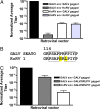Changes in viral protein function that accompany retroviral endogenization
- PMID: 17959780
- PMCID: PMC2077286
- DOI: 10.1073/pnas.0704313104
Changes in viral protein function that accompany retroviral endogenization
Abstract
Endogenous retroviruses (ERVs) are the remnants of ancient retroviral infections of germ cells and have been maintained in whole or part as heritable genomic elements. The last known endogenization events occurred several million years ago, and therefore stepwise analysis of retroviral endogenization has not been possible. A unique opportunity to study this process became available when a full-length ERV isolated from koalas (KoRV) was shown to have integrated into their germ line within the past 100 years. Even though KoRV shares 78% nucleotide identity with the exogenous and highly infectious gibbon ape leukemia virus (GALV), the infectivity of KoRV, like that of other ERVs, is substantially lower than that of GALV. Differences in the protein coding regions of KoRV that distinguish it from GALV were introduced into the GALV genome, and their functional consequences were assessed. We identified a KoRV gagpol L domain mutation as well as five residues present in the KoRV envelope (env) that, when substituted for the corresponding residues of GALV, resulted in vectors exhibiting substantially reduced titers similar to those observed with KoRV vectors. In addition, KoRV env protein lacks an intact CETTG motif that we have identified as invariant among highly infectious gammaretroviruses. Disruption of this motif in GALV results in vectors with reduced syncytia forming capabilities. Functional assessment of specific sequences that contribute to KoRV's attenuation from a highly infectious GALV-like progenitor virus has allowed the identification of specific modifications in the KoRV genome that correlate with its endogenization.
Conflict of interest statement
The authors declare no conflict of interest.
Figures



Similar articles
-
Episodic Diversifying Selection Shaped the Genomes of Gibbon Ape Leukemia Virus and Related Gammaretroviruses.J Virol. 2015 Dec 4;90(4):1757-72. doi: 10.1128/JVI.02745-15. Print 2016 Feb 15. J Virol. 2015. PMID: 26637454 Free PMC article.
-
In vitro characterization of a koala retrovirus.J Virol. 2006 Mar;80(6):3104-7. doi: 10.1128/JVI.80.6.3104-3107.2006. J Virol. 2006. PMID: 16501122 Free PMC article.
-
Endogenous Gibbon Ape Leukemia Virus Identified in a Rodent (Melomys burtoni subsp.) from Wallacea (Indonesia).J Virol. 2016 Aug 26;90(18):8169-80. doi: 10.1128/JVI.00723-16. Print 2016 Sep 15. J Virol. 2016. PMID: 27384662 Free PMC article.
-
Transspecies Transmission of Gammaretroviruses and the Origin of the Gibbon Ape Leukaemia Virus (GaLV) and the Koala Retrovirus (KoRV).Viruses. 2016 Dec 20;8(12):336. doi: 10.3390/v8120336. Viruses. 2016. PMID: 27999419 Free PMC article. Review.
-
Koala retroviruses: characterization and impact on the life of koalas.Retrovirology. 2013 Oct 23;10:108. doi: 10.1186/1742-4690-10-108. Retrovirology. 2013. PMID: 24148555 Free PMC article. Review.
Cited by
-
Construction and characterization of an infectious molecular clone of Koala retrovirus.J Virol. 2013 May;87(9):5081-8. doi: 10.1128/JVI.01584-12. Epub 2013 Feb 20. J Virol. 2013. PMID: 23427161 Free PMC article.
-
Polymorphic integrations of an endogenous gammaretrovirus in the mule deer genome.J Virol. 2012 Mar;86(5):2787-96. doi: 10.1128/JVI.06859-11. Epub 2011 Dec 21. J Virol. 2012. PMID: 22190723 Free PMC article.
-
Crossing Wallace's line: an evolutionarily young gibbon ape leukemia virus like endogenous retrovirus identified from the Philippine flying lemur (Cynocephalus volans).Sci Rep. 2025 Mar 21;15(1):9790. doi: 10.1038/s41598-025-94582-1. Sci Rep. 2025. PMID: 40118945 Free PMC article.
-
Geographic patterns of koala retrovirus genetic diversity, endogenization, and subtype distributions.Proc Natl Acad Sci U S A. 2022 Aug 16;119(33):e2122680119. doi: 10.1073/pnas.2122680119. Epub 2022 Aug 9. Proc Natl Acad Sci U S A. 2022. PMID: 35943984 Free PMC article.
-
Ancestral Mutations Acquired in Refrex-1, a Restriction Factor against Feline Retroviruses, during its Cooption and Domestication.J Virol. 2015 Nov 18;90(3):1470-85. doi: 10.1128/JVI.01904-15. Print 2016 Feb 1. J Virol. 2015. PMID: 26581999 Free PMC article.
References
-
- Tarlinton RE, Meers J, Young PR. Nature. 2006;442:79–81. - PubMed
-
- Johnsen DO, Wooding WL, Tanticharoenyos P, Bourgeois CH., Jr J Am Vet Med Assoc. 1971;159:563–566. - PubMed
-
- Heuschele WP, Hayes JR. Cancer Res. 1961;21:1394–1395. - PubMed
-
- Worley M, Rideout B, Shima A, Jansen D. Proc Annu Meet Am Assoc Zoo Vet. 1993;1:181–182.
MeSH terms
Substances
LinkOut - more resources
Full Text Sources
Research Materials
Miscellaneous

